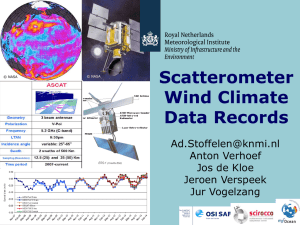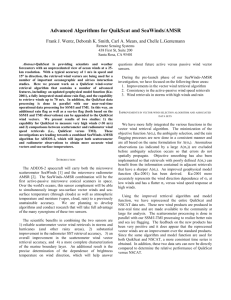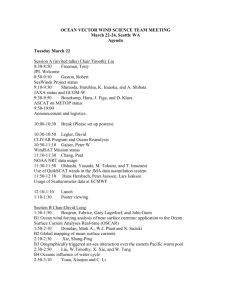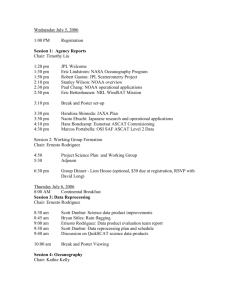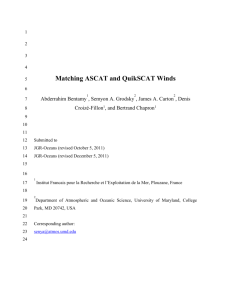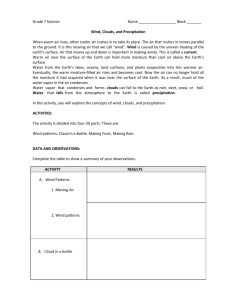Difference between collocated ASCAT and QuikSCAT Surface Wind
advertisement
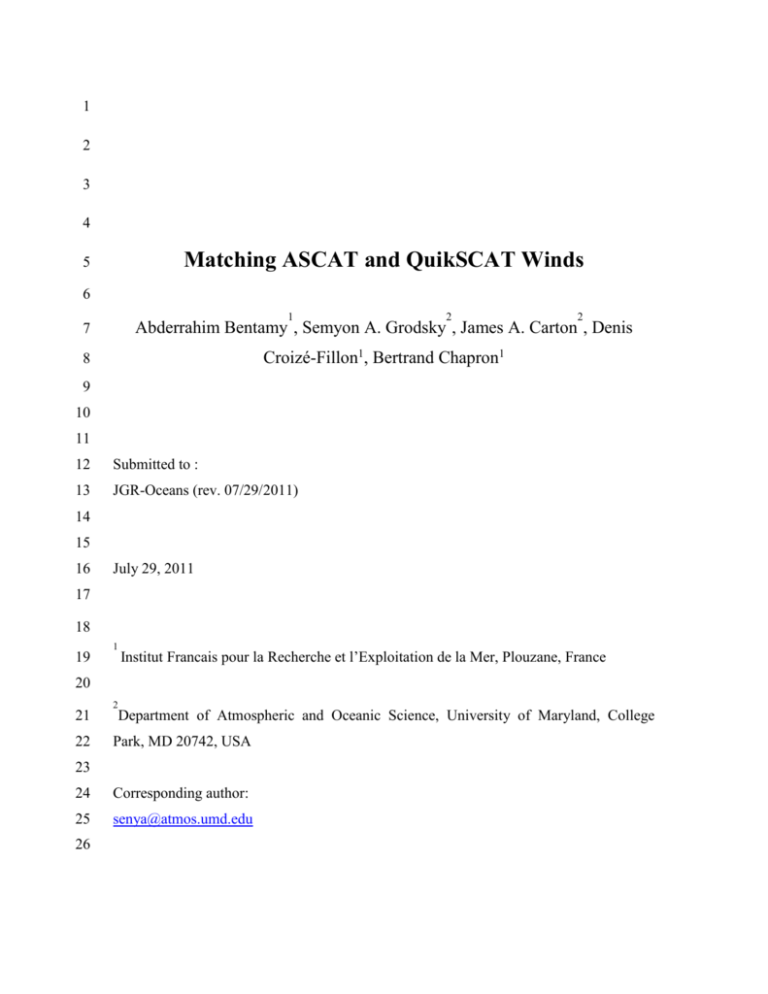
1 2 3 4 Matching ASCAT and QuikSCAT Winds 5 6 1 2 2 7 Abderrahim Bentamy , Semyon A. Grodsky , James A. Carton , Denis 8 Croizé-Fillon1, Bertrand Chapron1 9 10 11 12 Submitted to : 13 JGR-Oceans (rev. 07/29/2011) 14 15 16 July 29, 2011 17 18 19 1 Institut Francais pour la Recherche et l’Exploitation de la Mer, Plouzane, France 20 21 22 2 Department of Atmospheric and Oceanic Science, University of Maryland, College Park, MD 20742, USA 23 24 Corresponding author: 25 senya@atmos.umd.edu 26 1 Abstract 2 Surface winds from two scatterometers, the Advanced scatterometer (ASCAT), available 3 since 2007, and QuikSCAT, which was available through November 2009, show 4 persistent differences during their period of overlap. This study examines a set of 5 collocated observations during a 13-month period November 2008 through November 6 2009, to evaluate the causes of these differences. The difference in the operating 7 frequency of the scatterometers leads to differences that depend on rain rate, wind 8 velocity, and SST. The impact of rainfall on the higher frequency QuikSCAT is up to 1 9 ms-1 in the tropical convergence zones and along the western boundary currents even 10 after the rain flagging is applied. This difference from ASCAT is reduced by some 30% 11 to 40% when data for which the multidimensional rain probabilities >0.05 is also 12 removed. An additional component of the difference in wind speed seems to be the result 13 of biases in the geophysical transfer functions used in processing the two data sets and is 14 parameterized as a function of ASCAT wind speed and direction relative to the mid beam 15 azimuth. After applying the above two corrections, QuikSCAT wind speed remains 16 systematically lower (by 0.5 ms-1) than ASCAT over cold SST<5oC. This difference 17 appears to be the result of temperature-dependence in the viscous dumping which 18 differentially impacts shorter waves and thus preferentially impacts QuikSCAT. The 19 difference in wind retrievals also increases in the storm track corridors as well as in the 20 coastal regions where the diurnal cycle of breeze projects on the time lag between 21 satellites. 22 2 1 1. Introduction 2 Many meteorological and oceanic applications require the high spatial and temporal 3 resolution of satellite winds [e.g. Grima et al, 1999; Grodsky et al, 2001, Blanke et al, 4 2005; Risien and Chelton, 2008]. Many of these studies also require consistent time 5 series spanning the lifetime of multiple satellite missions, of which there have been seven 6 since the launch of the first European Remote Sensing satellite (ERS-1) in August 1991. 7 Creating consistent time series requires accounting for changes in individual mission 8 biases, most strikingly when successive scatterometers operate in different spectral bands 9 [e.g. Bentamy et al., 2002; Ebuchi et al., 2002]. This paper presents a comparative study 10 of winds derived from the matching of two such scatterometers: the C-band Advanced 11 SCATterometer (ASCAT) on board Metop-A and the higher frequency Ku-band 12 SeaWinds scatterometer onboard QuikSCAT. 13 Scatterometers measure wind velocity indirectly through the impact of wind on the 14 amplitude of capillary or near-capillary surface waves. This wave field is monitored by 15 measuring the strength of Bragg scattering of an incident microwave pulse. If a pulse of 16 wavenumber k impinges on the surface at incidence angle relative to the surface the 17 maximum backscatter will occur for surface waves of wavenumber of k B 2k sin( ) 18 whose amplitude, in turn reflects local wind conditions [e.g. Wright and Keller, 1971). 19 The fraction 0 of transmitted power that returns back to the satellite is thus a function 20 of local wind speed and direction (relative to the antenna azimuth), and . 21 To date, the most successful conversions of scatterometer measurements into near- 22 surface wind rely on empirically derived geophysical model functions (GMFs) 23 augmented by procedures to resolve directional ambiguities resulting from uncertainties 3 1 in the direction of wave propagation. Careful tuning of the GMFs is currently providing 2 estimates of 10m neutral wind velocity with errors estimated to be around ±1 ms-1 and 3 ±20o, [e.g. Bentamy et al., 2002; Ebuchi et al., 2002]. However systematic errors are also 4 present. For example, Bentamy et al. [2008] have shown that ASCAT has a systematic 5 underestimation of wind speed that increases with wind speed, reaching 1 ms-1 for winds 6 of 20 ms-1. 7 The GMFs and other parameters must change if the frequency band being used by 8 the scatterometer changes and historically scatterometers have used two different 9 frequency bands. US scatterometers as well as the Indian OCEANSAT2 use frequencies 10 in the 10.95-14.5GHz Ku-band. In contrast the European Remote Sensing satellite 11 scatterometers have all adopted the 4-8 GHz C-band to allow for reduced sensitivity to 12 rain interference [Sobieski et al, 1999; Weissman et al., 2002]. To avoid spurious trends 13 in a combined multi-scatterometer data set, the bias between different scatterometers 14 needs to be removed. 15 There have been numerous efforts to construct a combined multi-satellite data set of 16 winds [Milliff et al., 1999; Zhang et al, 2006; Bentamy et al, 2007, Atlas et al, 2011]. 17 These efforts generally rely on utilizing a third reference product such as passive 18 microwave winds or reanalysis winds to which the individual scatterometer data sets can 19 be calibrated. In contrast to such previous efforts, this current study focuses on directly 20 matching scatterometer data. 21 ASCAT and the recent QuikSCAT winds [following Bentamy et al., 2008]. 22 matching exploits the existence of a 13 month period November 2008 – November 2009 We illustrate the processes by matching the current This 4 1 when both missions were collecting data and when ASCAT processing used the current 2 CMOD5N GMF [Verspeek et al., 2010] to derive 10m neutral wind. 3 2. Data 4 This study relies on data from two scatterometers, the SeaWinds Ku-band (13.4 5 GHz, 2.2 cm) scatterometer onboard QuikSCAT (referred to as QuikSCAT or QS, Table 6 1) which was operational June, 1999 to November, 2009 and the C-band ASCAT 7 onboard the European Meteorological Satellite Organization (EUMESAT) MetOp-A1 8 (5.225GHz, 5.7 cm) launched October, 2006 (referred to as ASCAT or AS). 9 QuikSCAT uses a rotating antenna with two emitters: the H-pol inner beam with an 10 incidence angle =46.25° and the V-pol outer beam with an incidence angle of =54°. 11 Observations from these two emitters have swaths of 1400km and 1800km, respectively 12 which cover around 90% of the global ocean daily. These observations are then binned 13 into Wind Vector Cells of 2525 km. QuikSCAT winds used in this study are Level 2b 14 data estimated with the empirical QSCAT-1 GMF [Dunbar et al., 2006] and the 15 Maximum Likelihood Estimator which selects the most probable wind direction. To 16 improve wind direction estimates in the middle of the swath an additional Direction 17 Interval Retrieval with Threshold Nudging algorithm is applied. The winds produced by 18 this technique show RMS speed and direction differences from concurrent in-situ buoy 19 and ship data of approximately 1ms-1 and 23°, and temporal correlations in excess of 0.92 20 [e.g. Bentamy et al., 2002; Bourassa et al, 2003; Ebuchi et al, 2002]. The QuikSCAT 21 wind product includes several rain flags determined directly from the scatterometer 1 http://www.eumetsat.int/Home/Main/Publications/Technical_and_Scientific_Documentation/Technical_No tes/ http://www.knmi.nl/scatterometer/. 5 1 observations and from collocated radiometer rain rate measurements from other satellites. 2 The impact of rain on QuikSCAT data is indicated by two independent rain indices: rain 3 flag and multidimensional rain probability (MRP). 4 ASCAT has an engineering design that is quite different from QuikSCAT. Rather 5 than a rotating antenna it has a three beam antenna looking 45o (fore-beam), 90o (mid- 6 beam), 135o (aft-beam) of the satellite track, which together sweep out two 550 km 7 swaths on both sides of the track. The incidence angle varies in the range 34o-64o for the 8 outermost beams and 25o-53o for the mid-beam, giving Bragg wavelengths of 3.2-5.1cm 9 and 3.6-6.8 cm. Here we use level 2b ASCAT near real time data distributed by 10 EUMETSAT and by KNMI at 25x25 km2 resolution. Comparisons to independent 11 mooring and shipboard observations by Bentamy et al. [2008] and Verspeek et al. [2010] 12 show that ASCAT wind speed and direction has accuracies similar to QuikSCAT. 13 To reevaluate wind accuracy we use a variety of moored buoy measurements 14 including wind velocity, SST, air temperature, and significant wave height. These are 15 obtained from Météo-France and U.K. MetOffice (European seas) [Rolland et al, 2002], 16 the NOAA National Data Buoy Center (US coastal zone) [Meindl et al, 1992], and the 17 tropical moorings of the Tropical Atmosphere Ocean Project (Pacific), the Pilot Research 18 Moored Array (Atlantic), and Research Moored Array for African–Asian–Australian 19 Monsoon Analysis and Prediction project (Indian Ocean) [McPhaden et al., 1998; 20 Bourles et al., 2008; McPhaden et al., 2009]. Hourly averaged buoy measurements of wind 21 velocity, sea surface and air temperatures, and humidity are converted to neutral wind at 22 10m height using the COARE3.0 algorithm of Fairall et al. [2003]. 6 1 Quarter-daily 10m winds, as well as SST and air temperatures, are also obtained 2 from the European Centre for Medium Weather Forecasts (ECMWF) operational 3 analysis. These are routinely provided by the Grid for Ocean Diagnostics, Interactive 4 Visualization and Analysis (GODIVA) project2 on a regular grid of 0.5o in longitude and 5 latitude. 6 3. Collocated observations 7 Both satellites are on quasi sun-synchronous orbits, but the QuikSCAT local 8 equator crossing time at the ascending node (6:30 a.m.) leads the ASCAT local equator 9 crossing time (9:30 a.m.) by 3 hours. This difference implies that data precisely 10 collocated spatially are available only with a few hours time difference at low latitudes 11 (Figure. 1) [Bentamy et al, 2008]. Here we accept data pairs collocated in space and time 12 where QuikSCAT data is collected within 0< <4 hours and 50 km of each valid ASCAT 13 Wind Vector Cell. 14 For the thirteen month period November 2008 through November 2009 this 15 collocation selection procedure produces an average 2800 collocated pairs of data in each 16 1ox1o geographical bin. The data count is somewhat less in the regions of the tropical 17 convergence zones due to the need to remove QuikSCAT rain-flagged data. The data 18 count increases with increasing latitude as a result of the near-polar orbits, but decreases 19 again at very high latitudes due to the presence of ice. At shorter lags of <3 hours 20 collocated data coverage is still global, but the number of match-ups is reduced by a 21 factor of two. At lags of <1 hours collocated data is only available in the extra tropics 22 (Figure. 1). 2 behemoth.nerc-essc.ac.uk/ncWMS/godiva2.html 7 1 Next we explore possible impacts of nonzero time lag in the collocated data by 2 examining the temporal lag decorrelation time of buoy winds. In midlatitudes where the 3 characteristic time separation between collocated ASCAT and QuikSCAT data is less 4 than 2 hours we examine wind measurements from NDBC buoys. The original buoy data 5 is sub-sampled based on the timing of the nearest ASCAT (sub-sample 1) and QuikSCAT 6 (sub-sample 2) overpasses. The mean bias between subsamples at these extra tropical 7 NDBC mooring locations is close to zero with an RMS difference of less than 1ms-1, and 8 a temporal correlation >0.95. Negligible time mean bias at the buoys suggests that time 9 mean differences between collocated satellite wind fields (if any) is the result of 10 differences in the satellite wind estimates rather than the time lag between samples. 11 Similar results are found in an examination of data from the tropical moorings assuming 12 < 4 hr with no mean bias, RMS differences of 1.2 m/s, and temporal correlations >0.92. 13 Finally we examine the impact of the collocation space and time lag using the ECMWF 14 surface winds to simulate space and time sampling of ASCAT and QuikSCAT during the 15 period November 20, 2008 through November 19, 2009. This comparison also shows no 16 significant geographical patterns in the sampling bias. 17 Next we evaluate the accuracy of the satellite winds in the tropics by using this data 18 window to find triply-collocated ASCAT, QuikSCAT, and tropical mooring winds (here 19 we assume the mooring winds are unbiased). Both, QuikSCAT and ASCAT wind speeds 20 ( WQS and W AS ) agree well with collocated mooring wind speeds, Wbuoy , (Figure 2) with 21 time mean differences less than 1 m/s at all locations. ASCAT has a slight -0.35 ms-1 22 negative bias averaged over the moorings (Figure 3. In contrast, QuikSCAT mean wind 8 1 speed errors have a mixture of negative and positive biases, roughly mirror the spatial 2 distribution of rainfall and giving a mooring-average bias of -0.15 ms-1. 3 We evaluated the agreement of the time-dependent component of wind speed by 4 examining RMS differences and correlations of the collocated satellite and buoy winds. 5 This RMS difference averaged over all tropical buoys is 1.2 m/s and is well above the 6 mean wind speed bias. The correlation of satellite and tropical buoy winds is 0.8 at = 4 7 hr, but exceeds 0.9 at zero lag (Figure 4). At higher latitudes, where the winds have 8 longer synoptic timescales, the collocated satellite-buoy wind time series have even 9 higher correlations (0.89 at =4 hours, and 0.96 at less than half an hour, not shown). 10 4. Results 11 4.1 Global comparisons 12 Time mean difference of collocated QuikSCAT and ASCAT wind speed 13 ( W WQS W AS , Figure 5) is generally less than 1ms-1, but contains some planetary- 14 scale patterns. In general, W >0 at tropical to midlatitudes where it exhibits a pattern of 15 values in the range of 0.40-0.80 ms-1 resembling the pattern of tropical and midlatitude 16 storm track precipitation. This pattern suggests that even after applying the rain flag there 17 is a residual impact of rainfall on QuikSCAT wind retrievals (as previously examined by, 18 e.g. Weissman et al., 2002]. Enhancing rain flagging by removing cases with MRP > 19 0.05 (5% of QuikSCAT data) decreases the frequency of positive differences in the 20 tropical precipitation zones by some 30% to 40% and the number of large differences 21 W >1 ms-1 is reduced by 38% (Figure 5). However, the RMS variability of W 22 doesn’t change with the enhanced rain flagging. Both with and without additional rain 23 flagging RMS( W ) has a maximum of up to 3ms-1 in the zones of the midlatitude storm 9 1 tracks of both hemispheres and approaches 1.8 ms-1 in the tropical convergence zones. 2 These maxima in inter-instrument variability reflect a combination of still unaccounted 3 for impacts of rain events, and impacts of strong transient winds in the midlatitude storm 4 tracks, as well as deep convection events in the tropics. 5 In contrast to the tropics or midlatitudes, time mean W is negative at subpolar 6 and polar latitudes. This is particularly noticeable at southern latitudes where the 7 difference may exceed -0.5 ms-1. 8 difference remains even after applying enhanced rain detection to QuikSCAT (Figure 5). This striking high latitude inter-scatterometer 9 The temporal correlation of QuikSCAT and ASCAT winds is high (>0.9) over 10 much of the global ocean (Figure 5, CORR). It decreases to 0.7 (0.5 at some locations) in 11 the tropical convergence zones. This decrease occurs because in the tropics the space 12 scales of transient deep convective systems approache the scale of a single radar footprint 13 while the temporal scales of transients compare with the time lag between the two 14 satellites [Houze and Cheng, 1977]. In contrast, wind variability at mid and high latitudes 15 has long multi-day synoptic timescales and large spatial scales which result in high 16 correlations among collocated measurements. 17 4.2 Effect of geophysical model function 18 In this section we attempt to parameterize observed W (after applying enhanced 19 rain flagging to the QuikSCAT data) as a function of geophysical and satellite-earth 20 geometrical factors. The ASCAT GMF is parameterized by a truncated Fourier series of 21 wind direction (DIR) relative to antenna azimuth (AZIM) for each of the antenna beams 22 =DIR-AZIM as 23 0 B0 B1 cos B2 cos 2 , (1) 10 1 where the coefficients B depend on wind speed and incident angle, . This 2 suggests that a correction function dW (to be added to ASCAT winds in order to adjust 3 them to QuikSCAT winds) should depend on similar parameters, dW (W AS , , ) . Due to 4 the fixed, three beam observation geometry of ASCAT, the azimuthal dependence of 5 dW is reduced to dependence on ASCAT wind direction relative to the ASCAT mid- 6 beam azimuth, DIR AS AZIM 1 . In initial experiments we find that dW does not 7 depend on incidence angle (not shown). 8 Empirical estimates of this correction function dW are constructed by binning 9 observed W as a function of wind speed and . Here we begin by considering 10 estimates based on data from latitudes equatorward of 55o where the time mean W 11 values are positive. Figure 6 reveals a clear dependence on . For ASCAT mid-beam 12 looking in the wind vector direction ( =0o) W is small. Looking in the upwind 13 direction ( 180o) QuikSCAT wind speed is stronger than ASCAT by 0.5 m/s. 14 Looking in the cross-wind direction ( 90o) ASCAT wind speed is stronger than 15 QuikSCAT wind speed by approximately 0.2 ms-1. Similar azimuthal dependencies show 16 up when examining the difference between buoy wind speed and ASCAT wind speed 17 (Figure 7) although data scatter is larger due to the smaller number of satellite-buoy 18 collocations (compare right hand axes in Figures 6 and 7). 19 We next examine the dependence of W on both wind speed and azimuth (Figure 20 8). Independent of wind direction, QuikSCAT wind speed exceeds ASCAT at both low 21 winds ( WAS <3 ms-1) and high winds ( WAS >15 ms-1), with a larger difference at high 22 winds [see also Bentamy et al., 2008]. Independent of wind speed, QuikSCAT wind is 11 1 stronger than ASCAT if the ASCAT mid-beam is oriented in the upwind direction 2 ( 180o, compare with Figure 6). 3 Due to sampling errors, binned W are noisy at high winds (for which less data is 4 available) and are not symmetrical in azimuth (Figure 8a). To mitigate the impact of 5 sampling errors we represent dW by its mean and first three symmetric harmonics m 3 6 dW P5m (W AS ) cos( m ) , (2) m 0 7 where the coefficients P5m (W AS ) are assumed to be fifth order polynomials of ASCAT 8 wind speed. The polynomial coefficients in turn are estimated by least squares 9 minimization (Table 2). 10 To evaluate the usefulness of this approximation we compare its time mean 11 structure to that of the time mean of W in Figure 9. This comparison shows that most 12 of the spatial structure in the time mean of W is retained in the time mean of dW . 13 Applying the correction function (2) to instantaneous ASCAT winds leads to apparent 14 decrease in the residual time mean wind speed difference (compare WQS W AS and 15 WQS W AS dW panels in Figure 9). The unmodeled time mean difference includes 16 positive values in the regions of the midlatitude storm tracks, which is to be expected 17 because ASCAT underestimates strong winds (>20ms-1). Strong wind events are 18 relatively rare, and the correction function dW is uncertain at those conditions (Figure 19 8a). Some unmodeled time mean dW is also present in coastal areas such as off Peru and 20 Namibia, where we suspect there are sampling problems resulting from under-resolving 21 of the prominent diurnal land-sea breezes. 12 1 After correction for our modeled dW the global histogram of W WQS W AS 2 eliminates the slight 0.18 ms-1 positive bias in W (Figure 9). However large negative 3 tails of the distribution remain, reflecting the presence of large negative values of W at 4 high latitude mentioned previously. Here we explore a physically-based hypothesis for 5 this high latitude negative W . 6 4.3 Impact of SST 7 As described in the Appendix radar backscatter 0 depends on the spectrum of the 8 resonant Bragg waves. These near-capillary waves have amplitudes that depend on a 9 balance of wave growth and viscous dissipation, and the latter is a function of SST 10 because of the impact of SST on viscosity. 11 dependence of ΔW on SST through a Taylor series expansion of the growth-dissipation 12 equation around the space-time mean value of SST ( T0 =19oC) 13 W We present a linearized form of the 2[ (T ) (T0 )]( QS AS ) ( a / w )C C DW (1 c ) (3) 14 where notations and variable definitions are the same as in (A3). W is affected by 15 deviation of local SST from T0 through kinematic viscosity (T ) (T0 ) , and 16 inversely by increases in wind speed with some modifications due to changes in a . 17 These effects are relatively small over much of the ocean but increase at high latitudes 18 due to the increase in kinematic viscosity (Figure 10). The SST dependent bias varies 19 inversely with wind speed and thus is further enhanced south of 60oS due to the 20 combination of cold SSTs and relatively weak winds. 21 To summarize the impact of SST and winds on ΔW we present the QuikSCAT 22 minus ASCAT collocated differences binned as a function of wind speed and SST 13 1 (Figure 11). QuikSCAT wind speed is higher than ASCAT at low (<3 ms-1) and high 2 (>12 ms-1) winds. 3 SST<10°C under moderate wind 5 ms-1 < W <10 ms-1. The strongest negative wind speed 4 difference between the scatterometers is found at SST<5°C. In contrast to our 5 expectations from (3) the comparison in Figure 11 indicates that the negative difference 6 between ASCAT and QuikSCAT wind speeds rises in magnitude at moderate winds. The 7 explanation for this behavior likely requires an improved parameterization of the wind- 8 wave growth parameter and a more detailed radar imaging model (see Kudryavtsev et al., 9 2005 for further details). 10 In contrast, ASCAT wind exceeds QuikSCAT wind over cold 5. Summary 11 The end of the QuikSCAT mission in 2009 and the lack of a follow-on Ku band 12 scatterometer has made it a high priority to ensure the compatibility of QuikSCAT and 13 the continuing C band ASCAT mission measurements. 14 observations during a 13 month period of mission overlap November 2008-November 15 2009 shows that there are currently systematic differences in the 10m neutral wind 16 estimates from the two missions. This study is an attempt to identify and model these 17 differences in order to produce a consistent scatterometer-based wind record spanning the 18 period 1999 – present. Examination of collocated 19 The basic data set we use to identify the differences and develop corrections is the 20 set of space-time collocated satellite wind observations from the two missions and triply 21 collocated satellite-satellite-buoy observations during the 13 month period of overlap. 22 The first part of the study explores the acceptable range of spatial and temporal 23 separations between observations for comparison. Satellite and buoy winds show high 14 1 temporal correlation ( 0.8) for time lags of up to 4 hours and thus 4 hours was 2 determined to be the maximum acceptable time separation for winds stronger than 3.5 3 m/s. Requiring shorter time lags severely limits the number of collocated observations at 4 lower latitudes. Similarly, spatial separations of up to 50 km were determined to be 5 acceptable. 6 An examination of the collocated winds shows a high degree of agreement in 7 direction, but reveals systematic differences in speed that depend on rain rate, the 8 strength of the wind, and SST. The impact in wind speed of rainfall on the higher 9 frequency of the two scatterometers, QuikSCAT, is up to 1ms-1 in the tropical 10 convergence zones and the high precipitation zones of the midlatitude storm tracks even 11 after rain flagged data is removed. This 1 ms-1 bias is cut by half by removing QuikSCAT 12 wind retrievals with multidimensional rain probabilities >0.05 even though this additional 13 rain flagging reduces data amount by only 5%. For this reason we recommend the 14 additional rain flagging. 15 We next examine the causes of the differences in collocated wind speed remaining 16 after removing QuikSCAT winds with MRP>0.05. Examination of histograms shows 17 that the differences are partly a function of ASCAT wind speed and direction relative to 18 the mid beam azimuth, a dependence strongly suggesting bias in the ASCAT geophysical 19 model function. This dependence is empirically modeled based on the collocation data, 20 and is then removed. The bias model reduces collocated differences by 0.5 ms-1 in the 21 tropics where it has large scale patterns related to variability of wind speed and direction. 22 After applying the above two corrections, a third source of difference is evident in 23 that QuikSCAT wind speed remains systematically lower (by 0.5 ms-1) than ASCAT 15 1 wind speed at high latitudes where SST<5oC. An examination of the physics of wind 2 ripples implicates the SST-dependence of wave dissipation, an effect which is enhanced 3 for shorter waves. Again, the higher frequency scatterometer, QuikSCAT, will be more 4 sensitive to this effect. 5 Two additional sources of differences in the collocated observations are also 6 identified. Differences in wind retrievals occur in storm track zones due to 7 underestimation of infrequent strong wind events (>20 ms-1) by ASCAT. Differences in 8 wind speed estimates are also evident in the Peruvian and Namibian coastal zones where 9 diurnal land-sea breezes are poorly resolved by the time delays between passes of the two 10 scatterometers (up to 4 hours in this study). Here the differences seem to be a result of 11 the limitations of the collocated data rather than indicating error in the scatterometer 12 winds. 13 Acknowledgements. This research was supported by the NASA International 14 Ocean Vector Wind Science Team. We thank J. F. Piollé and IFREMER/CERSAT for 15 data processing support. The authors are grateful to ECMWF, EUMETSAT, CERSAT, 16 GODIVA, JPL, Météo-France, NDBC, O&SI SAF, PMEL, and UK MetOffice for 17 providing buoy, numerical, and satellite data used in this study. 18 16 1 Appendix. Impact of SST on the Bragg scattering 2 The purpose of this Appendix is to evaluate deviation in retrieved scatterometer 3 wind speed due to changes in SST. This evaluation is done for the pure Bragg scattering 4 and using simplified model of the Bragg wave spectrum. 5 Radar backscatter, 0 , is mostly affected by energy of the resonant Bragg wave 6 component. According to Donelan and Pierson [1997] for the pure Bragg scattering 7 regime radar backscatter 0 is a positive definite function of the spectrum of the resonant 8 Bragg wave component whose energy depends on the balance of wind wave growth 9 parameter w and viscous dissipation that is a function of SST, 0 F ( w ) . 10 For simplicity, we next consider waves aligned with wind and use the Plant [1982] 11 parameterization w a / wC (u* / c) 2 where a / w is the air to water density ratio, 12 C =32 is an empirical constant, u* C D W is the friction velocity in the air, C D is the 13 neutral drag coefficient that is parameterized as in Large and Yeager [2009]. This w 14 works over wide range of u* / c but fails at small values corresponding to threshold 15 winds [Donelan and Pierson, 1987]. It should be also corrected by a factor ( 1 c ), 16 where c is the wind-wave coupling parameter to account for the splitting of total wind 17 stress in the wave boundary layer into wave-induced and turbulent components [Makin 18 and Kudryavtsev, 1999; Kudryavtsev et al., 1999) 19 w a / wC (u* / c) 2 (1 c ) , (A1) 20 Viscous dissipation depends on the wavenumber, k , and frequency, , of the Bragg 21 component, 4k 2 1 . It also depends on the water temperature, T , through the 17 1 kinematic viscosity, (T ) , that explains temperature behavior of the wind-wave growth 2 threshold wind speed [Donelan and Pierson, 1987, Donelan and Plant, 2009]. We also 3 assume that scatterometer calibration, 0 (W ) , corresponds to the globally and time mean 4 ~ sea surface temperature T0 =19oC. Then an expected error in retrieved wind speed W due 5 to deviation of local temperature from T0 , T T T0 , is calculated by differentiating 6 along (T ,W ) const : 7 a / a w / T ~ W (k ) T / W w / W (A2) 8 The first term in (A2) accounts for changes in retrieved wind speed due to changes in the 9 air density [Bourassa et al., 2010]. For chosen w this term doesn’t depend on k , thus 10 doesn’t contribute to the wind difference between Ku- and C-band. Temperature 11 dependent difference between QS and AS winds is explained by the viscous term in (A2) 12 13 ~ ~ W W (k QS ) W (k AS ) 2 ( QS AS ) ( a / w )C C DW (1 c ) , (A3) where (T ) (T0 ) . 14 18 1 References 2 Atlas, R., R. N. Hoffman, J. Ardizzone, S. M. Leidner, J. C. Jusem, D. K. Smith, and D. 3 Gombos (2011), A Cross-calibrated, Multiplatform Ocean Surface Wind Velocity 4 Product for Meteorological and Oceanographic Applications. Bull. Amer. Meteor. 5 Soc., 92, 157–174. doi: 10.1175/2010BAMS2946.1 6 Bentamy, A., K B. Katsaros, M. Alberto, W. M. Drennan, and E. B. Forde (2002), Daily 7 surface wind fields produced by merged satellite data. American Geophys. Union, 8 Geophysical Monograph Series, 127, 343-349. 9 Bentamy, A., H-L Ayina, P. Queffeulou, and D. Croize-Fillon (2007), Improved Near 10 Real Time Surface Wind Resolution over The Mediterranean Sea. Ocean Sci., 3, 259- 11 271. 12 Bentamy, A., D. Croize-Fillon, and C. Perigaud (2008), Characterization of ASCAT 13 measurements based on buoy and QuikSCAT wind vector observations, Ocean Sci., 14 4, 265–274. 15 Blanke, B., S. Speich, A. Bentamy, C. Roy, and B. Sow (2005), Modeling the structure 16 and variability of the southern Benguela upwelling using QuikSCAT wind forcing, J. 17 Geophys. Res., 110 ,C07018, doi:10.1029/2004JC002529. 18 Bourassa, M. A., D. M. Legler, J. J. O’Brien, and S. R. Smith (2003), SeaWinds 19 validation with research vessels, J. Geophys Res., 108(C2), 3019, 20 doi:10.1029/2001JC001028. 21 Bourassa, M. A., E. Rodriguez, and R. Gaston (2010), NASA's Ocean Vector Winds 22 Science Team Workshops. Bull. Amer. Meteor. Soc., 91, 925–928. doi: 23 10.1175/2010BAMS2880.1 19 1 Bourle`s, B., and Coauthors (2008), The Pirata Program: History, accomplishments, and 2 future directions, Bull. Am. Meteorol. Soc., 89, 1111– 1125, 3 DOI:10.1175/2008BAMS2462.1. 4 Donelan, M. A., and W. J. Pierson Jr. (1987), Radar scattering and equilibrium ranges in 5 wind-generated waves with application to scatterometry, J. Geophys. Res., 92(C5), 6 4971– 5029, doi:10.1029/JC092iC05p04971. 7 8 9 Donelan, M. A., and W. J. Plant (2009), A threshold for wind-wave growth, J. Geophys. Res., 114, C07012, doi:10.1029/2008JC005238. Dunbar, S., and Coauthors (2006), QuikSCAT Science Data Product User's Manual 10 Overview & Geophysical Data Products, Jet Propulsion Laboratory, ftp://podaac- 11 ftp.jpl.nasa.gov/allData/quikscat/L2B/docs/QSUG_v3.pdf 12 Ebuchi, N., H. C. Graber, and M. J. Caruso (2002), Evaluation of wind vectors observed 13 by QuikSCAT/SeaWinds using ocean buoy data, J. Atmos. Ocean. Technol., 19, 14 2049-2069. 15 Fairall, C.W., E.F. Bradley, J.E. Hare, A.A. Grachev, and J.B. Edson (2003), Bulk 16 Parameterization of Air–Sea Fluxes: Updates and Verification for the COARE 17 Algorithm, J. Clim., 16, 571–591. 18 Grima, N., A. Bentamy, K. Katsaros, and Y. Quilfen (1999), Sensitivity of an oceanic 19 general circulation model forced by satellite wind stress fields, J. Geophys. Res., 20 104(C4), 7967-7989, doi:10.1029/1999JC900007. 21 Grodsky, S. A., and J. A. Carton (2001), Coupled land/atmosphere interactions in the 22 West African Monsoon, Geophys. Res. Lett., 28(8), 1503–1506, 23 doi:10.1029/2000GL012601. 20 1 Houze, R. A., and C.-P. Cheng (1977), Radar Characteristics of Tropical Convection 2 Observed During GATE: Mean Properties and Trends Over the Summer Season. 3 Mon. Wea. Rev., 105, 964–980. doi: 10.1175/1520- 4 0493(1977)105<0964:RCOTCO>2.0.CO;2 5 Kudryavtsev, V., V. Makin, and B. Chapron (1999), Coupled sea surface‐atmosphere 6 model 2. Spectrum of short wind waves, J. Geophys. Res., 104(C4), 7625-7639, 7 doi:10.1029/1999JC900005. 8 Kudryavtsev, V., D. Akimov, J. Johannessen, and B. Chapron (2005), On radar imaging 9 of current features: 1. Model and comparison with observations, J. Geophys. Res., 10 11 12 13 110, C07016, doi:10.1029/2004JC002505. Large, W. G., and S. G. Yeager (2009), The Global Climatology of an Interannually Varying Air-Sea Flux Data Set, Clim. Dyn., 33, 341-364. Makin, V., and V. Kudryavtsev (1999), Coupled sea surface‐atmosphere model 1. Wind 14 over waves coupling, J. Geophys. Res., 104(C4), 7613-7623, 15 doi:10.1029/1999JC900006 16 McPhaden, M. J., and Coauthors (1998), The Tropical Ocean-Global Atmosphere 17 observing system: A decade of progress, J. Geophys. Res., 103(C7), 14,169– 14,240, 18 doi:10.1029/97JC02906 19 McPhaden, M. J., and Coauthors (2009), RAMA: The Research Moored Array for 20 African–Asian–Australian Monsoon Analysis and Prediction. Bull. Amer. Meteor. 21 Soc., 90, 459–480, doi: 10.1175/2008BAMS2608.1 22 23 Meindl, E.A., and G.D. Hamilton( 1992), Programs of the National Data Buoy Center, Bull. Amer. Meteor. Soc., 4, 984-993. 21 1 Milliff, R. F., W. G. Large, J. Morzel, G. Danabasoglu, and T. M. Chin (1999), Ocean 2 general circulation model sensitivity to forcing from scatterometer winds. J. Geophys. 3 Res., 104(C5), 11 337–11 358, doi:10.1029/1998JC900045 4 Risien, C.M., and D.B. Chelton (2008), A Global Climatology of Surface Wind and Wind 5 Stress Fields from Eight Years of QuikSCAT Scatterometer Data, J. Phys. Oceanogr., 6 38, 2379-2413. 7 Rolland, J., and P. Blouch (2002), Les bouées météorologiques, Météo France 8 Publication, La météorologie 39, available online at 9 http://documents.irevues.inist.fr/bitstream/handle/2042/36252/meteo_2002_39_83.pd 10 11 f Sobieski, P. W., C. Craeye, and L. F. Bliven (1999), Scatterometric signatures of 12 multivariate drop impacts on fresh and salt water surfaces, Int. J. Remote Sens., 20, 13 2149-2166. 14 Verspeek, J.; A. Stoffelen, M, Portabella, H. Bonekamp, C. Anderson, and J.F. Saldana 15 (2010), Validation and Calibration of ASCAT Using CMOD5.n, IEEE Transactions 16 on Geoscience and Remote Sensing, 48, 386-395, doi: 10.1109/TGRS.2009.2027896 17 Weissman, D. E., M. A. Bourassa, and J. Tongue (2002), Effects of Rain Rate and Wind 18 Magnitude on SeaWinds Scatterometer Wind Speed Errors, J. Atmos. Oceanic 19 Technol., 19, 738–746. doi: 10.1175/1520- 20 0426(2002)019<0738:EORRAW>2.0.CO;2 21 22 Wright, J. W., and W. C. Keller (1971), Doppler spectra in microwave scattering from wind waves, Phys. Fluids, 14, 466-474. 22 1 Zhang, H.-M., J. J. Bates, and R. W. Reynolds (2006), Assessment of composite global 2 sampling: Sea surface wind speed, Geophys. Res. Lett., 33, L17714, 3 doi:10.1029/2006GL027086. 4 23 1 Table 1 Orbital parameters Satellite QuikSCAT METOP-A Recurrent period 4 days 29 days Orbital Period 101 minutes 101 minutes Equator crossing Local Sun 6:30 a.m 9:30 a.m. time at Ascending node Altitude above Equator 803 km 837 km Inclination 98.62o 98.59o 2 5 3 Table 2 Coefficients aim of P5m (W AS ) aim (W AS ) i in (2) which parameterizes the i 0 4 difference between QuikSCAT and ASCAT wind speeds in terms of ASCAT wind speed 5 ( WAS ) and wind direction relative to ASCAT mid-beam azimuth ( ). Columns represent 6 coefficients aim for angular harmonics cos( m ) in (2), m=0,1,2,3. 7 1 cos cos 2 cos 3 Factor 1 1.6774 0.1427 0.0894 0.2229 x1 WAS -0.7974 0.2091 0.2806 -0.2903 x1 WAS2 1.3854 -0.7235 -0.6268 0.8371 x 0.1 WAS3 -1.1416 0.7916 0.5320 -0.9592 x 0.01 WAS4 0.4476 -0.3579 -0.1906 0.4681 x 1e-3 WAS5 -0.6307 0.5709 0.2322 -0.8181 x 1e-5 8 24 1 2 3 4 5 6 Figure 1. Number of collocated QuikSCAT and ASCAT data on a 1ox1o grid during 7 November 2008-2009 for time separations less than that shown in the left-upper corner. 8 25 1 2 3 Figure 2. Difference between time mean satellite and buoy 10m neutral wind speed (ms-1) 4 for QuikSCAT (QS,top) and ASCAT (AS,bottom). 5 26 1 2 3 Figure 3.Scatter diagram of satellite and buoy 10m neutral wind speed for ASCAT (AS) 4 and QuikSCAT (QS).Symbols represent time mean collocated winds at buoy locations. 5 27 1 2 3 Figure 4. Lagged correlation of collocated satellite and buoy winds as a function of time 4 separation between satellite and buoy data. Solid line shows the median value and 5 vertical bars are bounded by 25 and 75 percentiles of correlation for different buoys. 6 28 1 2 3 4 Figure 5. Mean difference between collocated QuikSCAT and ASCAT wind speed 5 ( W ), their standard deviation (STD), and temporal correlation (CORR). (Left) only rain 6 flag is applied to QuikSCAT, (right) rain flag and multidimensional rain probability 7 (MPR<0.05) are both applied. 8 29 1 2 3 Figure 6. Difference between collocated QuikSCAT (QS) and ASCAT (AS) wind speed 4 as function of ASCAT wind direction relative to the mid beam azimuth (DIR ASC- 5 AZIM1). Data is averaged for all wind speeds and binned into 10o in the relative wind 6 direction. Downwind direction corresponds to 0o. Wind direction histogram is shown in 7 gray against the right axis. 8 30 1 2 3 4 Figure 7. The same as in Figure 6, but for buoy minus ASCAT collocated wind speed 5 difference. 6 31 1 2 Figure 8. Collocated QuikSCAT-ASCAT neutral wind speed difference (m/s) binned into 3 1m/s by 10o bins in ASCAT wind speed and wind direction relative to the ASCAT mid- 4 beam azimuth DIR AS AZIM 1 . (a) Binned data, evaluated with data from 55S -55N 5 to exclude high latitude areas of negative W (see Figure 5). (b) data fit by equation (2). 6 32 1 2 Figure 9. (top panel) Wind speed difference ( WQS W AS ). QuikSCAT rain flag and 3 MRP<0.05 are applied (the same as in Figure5). (2nd panel) Wind speed difference after 4 applying the correction function dW (WAS , ) . (3rd panel) Spatial distribution of time 5 mean dW . (lower panel) Histogram of wind speed difference before (gray bar) and after 6 (empty bar) applying of dW . 7 33 1 2 1 Figure 10. (top panel) Time mean inverse wind speed from ASCAT, W AS . (2nd panel) 3 Difference in kinematic viscosity (m2s-1) of the sea water relative to the viscosity 4 evaluated at global mean SST (19oC). (third panel) QuikSCAT-ASCAT wind speed 5 difference after applying the correction function dW (the same as in Figure 9). (bottom 6 panel) SST dependent difference between QuikSCAT and ASCAT wind speed 7 W (T ) based on (Eq. 3) at =45o. 34 1 2 3 4 5 Figure 11. Collocated QuikSCAT-ASCAT neutral wind speed difference (ms-1) binned 1o 6 in SST and 1m/s in wind speed from the ECMWF analysis collocated data. There are on 7 average 128,000 collocations in each bin. Only wind speed difference based on more than 8 2,000 collocations is shown. 35
